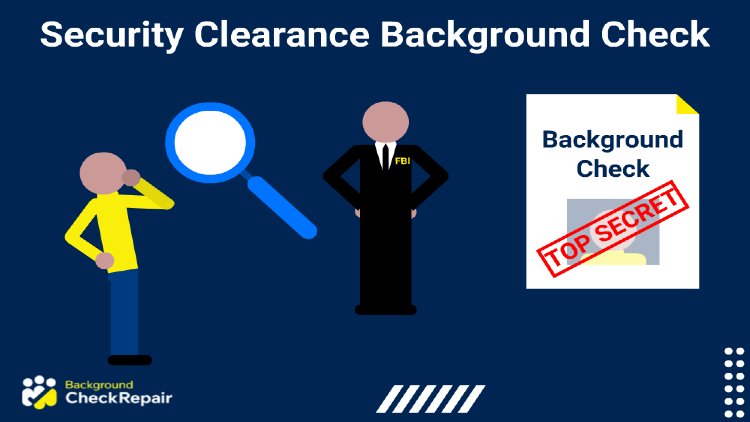
A security clearance background check is used for a number of jobs in the public sector, some of which may not even require classified information or access to sensitive programs.
But, there are various levels of a security clearance background check, and different time frames involved and a few things that anyone should understand before applying for a position that requires a security clearance.
Understanding the process and the information required, as well as how far back a security clearance background check goes (compared to how far back a more typical level 2 background check goes) are the keys to being prepared for an interview and application ahead of time.
How Many Security Clearance Levels Are There?
Applications for specific job positions, primarily government-based and federal positions in the public sector, must undergo a specific kind of background screening that determines if the individual is suitable for the required security clearance certificate.
Since an individual may have access to sensitive information, security clearances are imperative to the safety of the country as a whole and the United States government.
In short, a security clearance is a process that occurs after a suitability review. The suitability review determines if the individual has the character and reputable background to continue with the process.
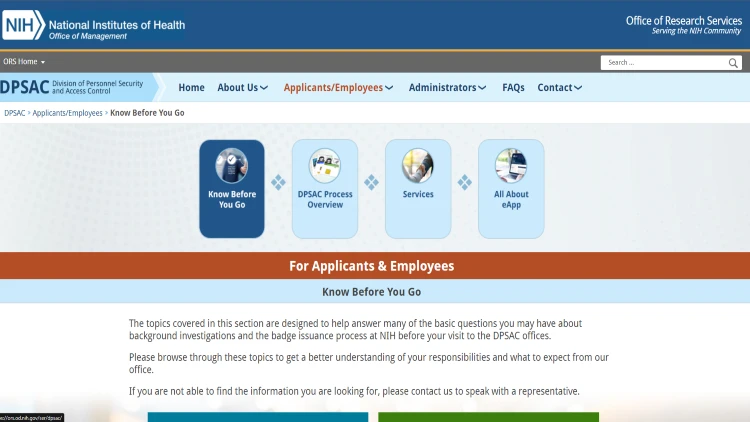
Agencies like the National Institute of Health (NIH) require personnel security clearance for access.
This review does not determine if the person should have access to the highly classified government information but simply directs them to the next step if they pass.
After the suitability review, the security clearance background check determines if the person applying for the specific job opening should have access to classified national security information, should not have access, or if the person may be a threat. The security clearance focuses on the history and background of the person, specifically on the person’s past, personal associations, and conduct.1
During this phase, the applicant will accept the provisional offer from the government or the organization, and provide consent to undergo a security clearance check. The sponsoring agency is the business that decides the necessary level of clearance.
For applicants, it is essential to know that there are six primary security clearance levels.
Six Security Clearance Levels
The six levels of security clearance outline the importance of the role in question, the information necessary to perform this job role, and what may appear on a security clearance background check.2
- Level 1 — This is the most basic level of sensitivity re-investigation and only contains non-sensitive information. Individuals must use the SF85 form to obtain security clearance and suitability determination.
- The Advance National Agency Check with Inquiries conducts this security-level clearance that involves civilian employees.
- Level 2 — This is the second level of the security clearance that focuses on national information, security information, and non-critical or sensitive information. The application form for this clearance is the SF86 which provides security clearance for confidential, secret, or DOE “L” information.
- The National Agency Check with Law and Credit conducts this security clearance for re-investigations.
- The Level 2 security clearance requires the L Clearance — this allows access to classified information regarding limited (“L”) areas, which typically involve nuclear materials and the Nuclear Regulatory Commission.3

The questionnaire on the SF86 Form includes multiple pages and requires applicants to include a significant amount of personal information.
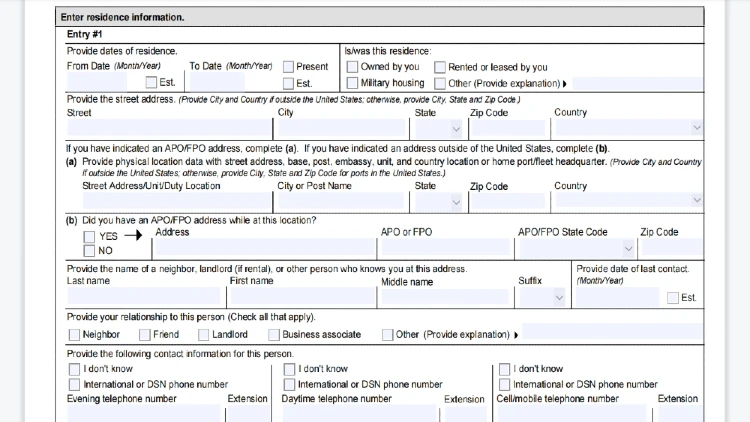
In addition to residency information, the SF86 form requires contact information for others who can verify the residency claims.
- Level 3 — The third level of security clearance contains national, security, critical, and sensitive information. An individual must use the SF86 form to obtain top-secret information after passing the SSBI investigation.
- The Single Scope Background Investigation conducts this records check regarding initial top-secret, SCI, Q, or QX information.
- Level 4 — The fourth level of security clearance contains national, security, special, and sensitive information. The applicant must complete the SF86 form to obtain top secret with SCI eligibility or DOE access.
- This security clearance provides access to Q Clearance — providing access to Classified Information, Restricted Data, and Q-cleared areas. 4
- Level 5 — There are two levels to the level 5 security clearance. The first is Level 5, which allows individuals to view public trust information that poses a moderate risk to society. Even though applicants may think that a public trust position obtains a security clearance, this is not the same access as the freedom to obtain confidential information. However, Public Trust Positions are still designated as either moderate or high-risk, depending on the specific type of sensitive information. 5
- The second type of fifth-tier security clearance is Level 5, which provides national and security information. This level 5 security clearance contains secret information and moderate risk.
- The Moderate Risk Background Investigation conducts Level 5 security clearances regarding inquiries to employers and references.
- Level 6 — There are three types of Level 6 security clearances: public trust, duties, and national security.
- The Public Trust Level 6 security clearance contains high-risk information. Individuals can obtain this level of clearance after completing the BI form.
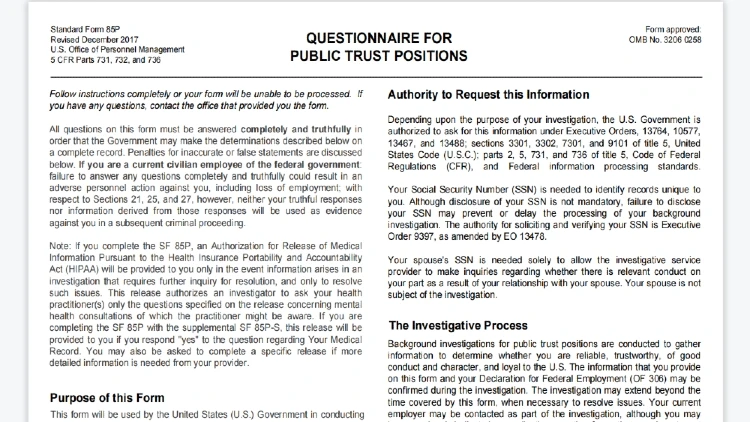
Public trust positions require field investigations to confirm claims made about criminal history, employment, and associations.
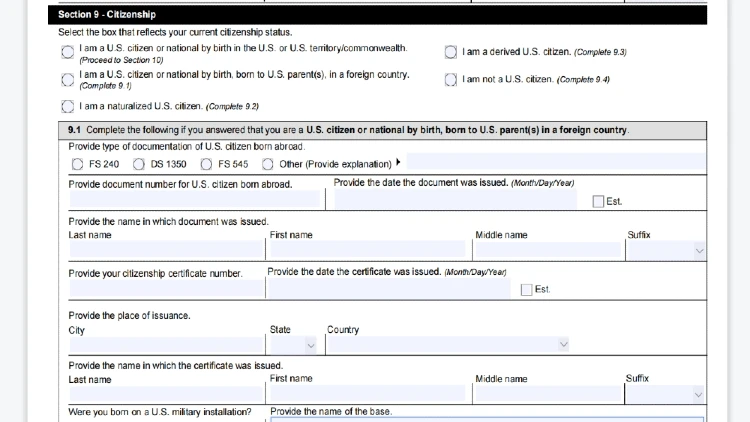
- The Public Trust and Duties clearance is granted after completing the BI form. This clearance provides individuals with access to see high-risk involving designated information.
- The national information and security information clearance requires secret and high-risk access.
Security Clearance Levels Chart
What are the 6 levels of security clearance? Not counting the non-sensitive positions that are required to complete the SF85-13 Form, the levels graduate in intensity.
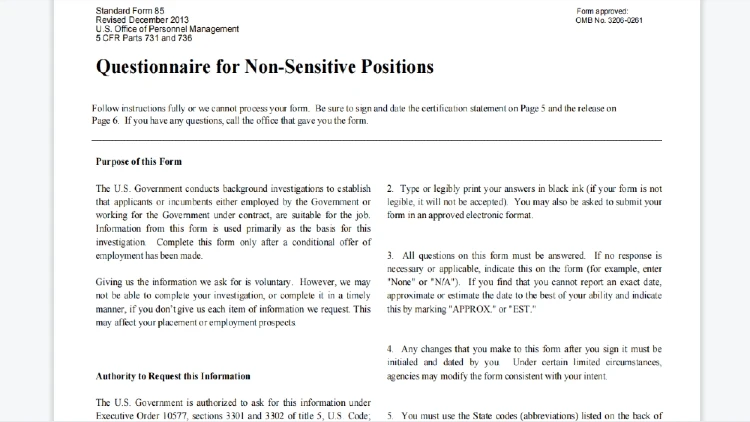

The following chart outlines the basics of the types of security clearance levels, the background check organization, the application form, and the re-investigation timeline required is helpful to all job position applicants.
| Security Clearance Sensitivity Level | Security Clearance Background Check Investigation Type | Application form | Required |
| Level 1 | None or NACI | SF85 | None |
| Level 2 | NACLC or ANACI | SF86 | NACLC every 5 Years |
| Level 3 | SSBI | SF86 (Guide for completion) | SSBI-PR every 5 Years |
| Level 4 | “Q” SSBI | SF86 | SSBI-PR or PPR every 5 Years |
| Level 5 – Public Trust | MBI | SF85P | NACLC |
| Level 5 – National Security | MBI | SF86 | NACLC every 5 years |
| Level 6 – Public Trust | BI | SF85P | PRI every 5 years |
| Level 6 – Public Trust Duties | BI | SF85P-S | PRI every 5 years |
| Level 6 – National Security | BI | SF86 | PRI every 5 years |
Types of Background Check for Security Clearance: Security Clearance Background Investigation
There are different security clearance large-scale background checks and investigation types to understand regarding federal background screening for employment.
NAC Check (National Agency Check)
The National Agency Check is the minimum requirement for individuals looking to access ‘secret’ and ‘top secret’ information for specific personnel categories. The National Agency Check is one of the main staples of the traditional background investigation for those who wish to access sensitive information.

Image Source: https://www.govinfo.gov
A National Agency Check includes a minimum of three agencies, but can also include any requested check on various agencies. These additional checks may take into account investigative documents, investigative activities of military departments, and the Defense Central Index of Investigations records of the person in question.
Government workers can also conduct the Expanded National Agency Check, which includes interviews, inquiries, and additional information regarding the person in question for a more thorough analysis.
NACI Check (National Agency Check With Written Inquiries)
The National Agency Check with Written Inquiries is the add-on to the aforementioned National Agency Check. This check includes the inquiries conducted by the Office of Personnel Management in the security clearance check.
Therefore, individuals who are subjected to this type of check must also be aware that the government background check will analyze all written inquiries to law enforcement offices, previous employers, and references.
ANACI Check (Access National Agency Check Investigation)
A step above the National Agency Check, the ANACI, the Access National Agency Check Investigation, is a new type of required initial investigation for federal employees who require access to sensitive programs and classified information that is categorized as the Secret or Confidential Level.
The ANACI Check includes the basic NACI information, plus local police checks 6
NACLC Check (National Agency Check With Local Agency Check and Credit Check)
Another variation of the National Agency Check is the National Agency Check with Local Agency Check and Credit Check. This type of ANACI variation includes inquiries to past employers, financial and tax information, and past educational history.
This investigation aims to determine if the person in question meets the basic investigation requirements for those with current Confidential Or Security clearances.
SSBI Check (Single Scope Background Investigation)
The single-scope background investigation check is used as a standard for all agencies who wish to grant access to Extremely Sensitive Information programs, Special Access Required programs, Compartment Information programs, or Collateral Top Secret Information.
The single-scope background investigation contains all of the fundamental aspects of the background investigation (BI check) and includes additional information that can create a comprehensive picture of the person’s life as a whole. The investigations are much more thorough, ensuring the agency can garner a complete picture of the person in question to see if they are eligible to meet the security clearance standards regarding highly sensitive information.
SSBI-PR Check (Single Scope Periodic Re-Investigation)
The Single Scope Periodic Re-investigation is used to conduct a current investigation for individuals who have access to Top Secret clearances. Instead of going through the entire SSBI process from scratch, these individuals can simply go through the re-investigation process during the specified coverage period.
MBI Check (Moderate Risk Background Investigation)
Moderate Risk Background Investigation contains the National Agency Check with Inquiries plus an additional candidate interview. Seeing and talking to the individual in question in person can provide government workers with an additional feeling of how trustworthy they are in providing access to confidential documents and programs.
High-risk positions require Background Investigation, which is the next form of the MBI Check. In short, this type of security clearance background check contains the personal subject interview and written inquiries to past references and employers for a comprehensive view of the person’s character. 7
BI Check (Background Investigation)
This Background Investigation is the minimum necessary for granting any level of security clearance to individuals applying for certain programs or accessing top-secret clearance. 8 The BI check was to determine individuals’ previous activity and relationships to determine if they are suitable or safe to view classified information.
The information regarding the person’s past can provide government employees and security organizations with the necessary tools to determine if this person is safe to view sensitive program information. This check mainly focused on the participant’s character, personality, and bad relationships, such as the loyalty and integrity of the person in question.
A traditional background investigation check now encompasses developed character references, past employment history, and interviews. The combination of the interview process, past references, credit checks, local agency checks, and character references can provide the government with enough information regarding the decision on the applicant.
What Is a Secret Security Clearance Background Check?
A secret security clearance background check is a tool and investigative method the government uses to determine if a person is allowed access to top-secret programs or classified information.
Most information required by law enforcement is shared throughout the state and federal levels — therefore, security clearances are required to provide individuals with limited access to sensitive material.
A secret clearance background check is only given to those who must know about specific national security information to help protect the country. This information is provided to individuals at either a Confidential or Secret level.
The Top Secret security clearance is only given to individuals who are on a “need to know” basis regarding national information and unrestricted access to the tools at the disposal of the Federal Bureau of Investigation.
The background investigation aims to ensure the person in question is not a detriment to national security and can be trusted with classified information and access to governmental programs. The applicants considered for the security clearance are evaluated in terms of mental fitness, past references, character, employment history, honesty, and association with foreign nationals.
What’s Involved in a Security Clearance Background Investigation Interview?
Once a person provides the necessary information required for the security clearance, there will be an interview process for the government to “get to know” the person and determine if they are safe to provide access. These interviews involve the person in question and any spouse within the past ten years to clear up any lies or inconsistencies in the person’s past.
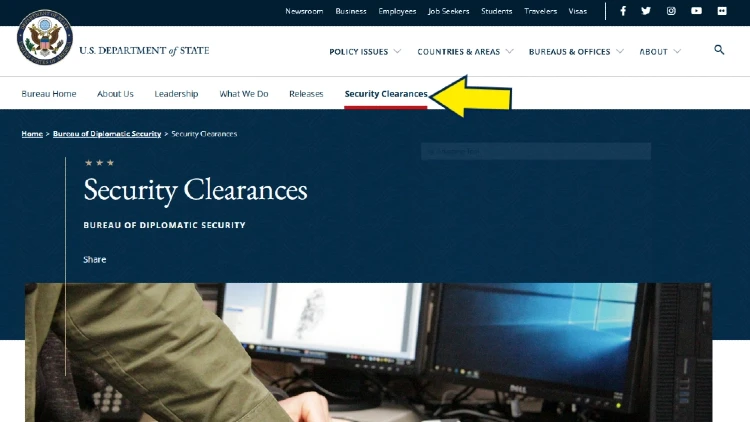
To be prepared beforehand, individuals must know the dos and don’ts of the interview process. Those applying for security clearance must bring their SF86 form and understand what may be asked ahead of time to avoid any nerves. 9
How Long Does a Security Clearance Background Check Take?
The length of time a security clearance background check will depend on the thoroughness of the investigation and the type of clearance required. For example, the minimum requirements may take a shorter time period than individuals who are looking to get a level 5 security clearance.
Although it depends on the specific type of clearance required, the general time frame is between 4-8 weeks for a security clearance background check. Applicants must ensure they submit all documentation within one week of receiving the Personnel Security Team’s email to avoid any slowdowns in the processing time. Applicants must also keep an eye on their email after their submission to ensure they see the final decision on clearance.
How To Get DOD Security Clearance
A Department of Defense security clearance is imperative for any person who needs a secret-level security clearance. It doesn’t matter if the applicant in question is a civilian member or a current United States military member; the person in question will still require the DoD Security Clearance. But how do the DOD security clearance requirements differ from other security clearances?
There are a few things to keep in mind for those who need to obtain a DoD Security clearance.
- First, an employer or DoD-related contractor must request this type of clearance; individuals cannot request a DoD clearance on their own.
- Second, the DoD clearance typically goes hand-in-hand with an applicant looking to work in the DoD sector or obtain a Department of Defense position.
- Third, this type of security clearance has a longer wait time than other clearances, typically taking between 6 months to one year to be issued (compared to the typical 4-8 weeks).
Individuals must be aware of the differences in the application process for the DoD process compared to the other security clearances. The basic steps involve filling out the SF86 form through the online e-QIP program or a print-out version of the form. This SF86 form contains extensive information regarding a person’s past, references, character, travel, employment history, educational history, and residence.
The next step of the DoD security clearance involves fingerprinting and testing. Individuals who need to be cleared by the Department of Defense have to run their fingerprints against other databases and levels of government to ensure there are no unlawful relationships or criminal history.
The third step of obtaining the DoD security clearance is the interview process which includes information about the person’s past, character, relationships, past investigations, and standing in society. The government personnel will measure your answers against your co-workers, friends, family, and neighbors to see if the answers match up. 10
5 Automatic Security Clearance Disqualifiers
There are 5 automatic disqualifiers for security clearances that will immediately take a person out of the running for an open job position. Although there are numerous security clearance disqualifiers that can prevent a person from obtaining a highly sensitive job role, these are the top five automatic disqualifiers to avoid during an interview and application process. 11
- Non-Allegiance to the US — The first red flag during a security clearance is a lack of allegiance to your national country. A background investigation will determine if there have been any attempts (successful or unsuccessful) of sabotage or treason against the United States.
- Foreign Preference — The second disqualifier for national security clearance is foreign allegiance or preference to another country besides your national country. A foreign preference is indicative of influence to sway towards another country’s wishes. A person may be disqualified if they seek office in another country, obtain benefits through another country, serve in the military of another country, or vote in foreign elections.
- Risky Sexual Behavior — Sexual misconduct or inappropriate behavior indicates the person is of low moral standing and behaves in a risky manner.
- Untrustworthy Personal Conduct — A security clearance may reveal that a person has a pattern of dishonesty.
- Poor Financial Standing – The last disqualifier for a security clearance is how a person handles their money. Many instances of debt, fraudulent holdings, or risky financial behavior (ex: gambling) can disqualify a person from obtaining a clearance.
Also, a person’s social security number will be looked up with E-Verify, to ensure that they are able to legally work in the United States.
Does the Federal Bureau of Investigation (FBI) Conduct the Security Clearance Background Check?
The Federal Bureau of Investigation works with other law enforcement agencies to determine if the person in question can obtain a security clearance background check.
Since they need to pull records from various states and jurisdictions, they check the records of different federal agencies and state law enforcement agencies to determine the fitness of the applicant or person in question.
Individuals who require access to sensitive information or confidential programs must be aware that the government carries out checks and interviews to determine if they are suitable to be privy to this information. Understanding the different levels of security clearances and the basic security clearance background check process can help.
Frequently Asked Questions About Security Clearance Background Check











